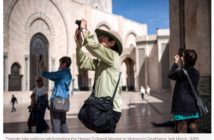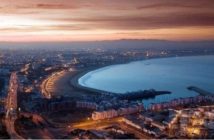Casablanca: Find the spirit of Rick’s Cafe
November 27, 2012, 2:45 pm
Paul Schemm – AAP
Casablanca is a vibrant, noisy metropolis and Morocco’s commercial capital, and nothing like the wartime colonial outpost depicted in the iconic film.
Seven decades after the premiere of the film classic Casablanca, the Moroccan port city remains firmly associated in many peoples’ minds with the movie, even though Rick’s Cafe Americain, where much of the story took place, was a pure creation of Hollywood.
Casablanca, a story of love and intrigue during World War II, premiered on November 26, 1942. Today, the city is a vibrant, noisy metropolis of four million people and Morocco’s commercial capital, nothing like the wartime colonial outpost depicted in the iconic movie, which starred Humphrey Bogart as Rick. But a trip through the city’s swanky lounges and dive bars can still evoke the spirit of the cafe from the movie. There’s even a real-life Rick’s Cafe here, founded by an American expat.
In the film, Rick’s Cafe Americain, an expansive space spanned by low arches, had it all: a casino, singers, full brass band and round tables where guests hunched conspiratorially, drinking and talking about resisting the Nazis or getting exit visas to flee to America.
Outside the cafe’s panelled doors, the movie depicted Hollywood’s “Middle East” with generic dusty streets and markets. Characters talked about “rotting” away in Casablanca, described as being in the middle of a desert. In fact, Casablanca in 1942 was a jewel of the French colonial empire, famous for luscious art deco and neo-classic architecture.
“During the 1940s, Casablanca was a laboratory for European architects,” said Adel Saadani, who works to raise awareness of the city’s neglected heritage. “There was space and there was money and there was a carte blanche for architects to experiment with designs they couldn’t do in Europe.”
Those buildings still stand, though some are a bit worse for the wear. Casablanca’s downtown still looks like a European city in the 1950s with an “oriental” twist. The downtown is centred around the arched colonnades of Mohammed V street, lined by stately art deco wonders. Cars are banned from the street in preparation for a tramway opening mid-December.
For decades after the war, said Saadani, Casablanca was filled with jazz clubs and cabarets that hosted the likes of Dizzy Gillespie, Louis Armstrong and Josephine Baker. The movie’s pianist, Sam, would have fit right in.
But the last jazz club closed in 1984 amid conservatism and a turn away from Western music. Downtown bars and once-tony spots fell into disfavour. At the same time, rural migrants flooded in looking for jobs. Cheap, ugly, unregulated high rises sprung up as the city mushroomed. The upper classes moved to new developments on the edges of town and along the Atlantic beaches.
Tourists passing through the city looking for Rick’s in those years were often disappointed by traffic-choked streets and the glass and concrete tower blocs of a modern city. But in recent years, more nightspots have opened, including, in 2004, Rick’s Cafe.
“I was amazed in my four years here that no one ever thought of establishing a Rick’s Cafe,” recalled its owner, Kathy Kriger. Her previous career as a diplomat in Casablanca’s US consulate gave her the connections she needed to open the restaurant amid Morocco’s red tape and bureaucracy. Every time her project stalled, she called in favours from the capital, Rabat, pulling strings just like Bogart did in the movie.
“I used him as a mentor when I was doing this project,” admitted Kriger. “I often wondered, what would Rick do?”
Her elegant restaurant, in a 1930s townhouse on the edge of Casablanca’s medina, is awash in nostalgia for the classic film. Kriger can be found most nights perched on the end of the long bar, while a piano player – named Issam, not Sam – plays the movie’s theme song, As Time Goes By, repeatedly through the night to a packed house.
And while the only item on Bogart’s menu seemed to be caviar, Kriger offers a full menu of Moroccan and continental cuisine. “I take the movie as a basis but make it more luxurious and better,” said Kriger.
The real-life Rick’s is a hit, filled with well-heeled locals and visitors from everywhere, from Atlanta, Georgia, to Japan. Outside a tour bus is usually parked next to the BMWs and Audis of the dinner crowd.
Yet contemporary nightlife in Casablanca offers more than nostalgia. The conspiratorial feel of Rick’s Cafe is also evoked in La Cigale (the Cicada), a downtown haunt of intellectuals and journalists. The bar at first glance has the intimidating look of many Casablanca dives, with too many moustaches and cigarettes. But in back, the place widens out to an arched room filled with all ages. A stone-faced waitress known as Nora deftly moves her matronly form through the crowd, popping open beer bottles one-handed as she deposits them on tables, saving the occasional half-smile or smirk for young regulars.
Music from a coin-operated jukebox can get the crowd dancing beneath a few coloured lights and a half-disco ball, while aspiring musicians take the stage for open mike nights.
The walls bear photos of regulars, called “Children of the Cigale”, as well as paintings of traditional scenes and the odd portrait of the royal family. Chatter ranges from the latest palace outrage against democracy to last night’s romantic exploits.
Also downtown is the Cintra, a cramped bar known for cheap beer and live Arabic music, open until the wee hours. Upstairs in the mezzanine, aficionados of the Arabic lute, or oud, gather to hear thoughtful performances, while downstairs it’s noisy, raucous and good natured.
For the most part, however, Casablanca’s nightlife has moved away from downtown. The remaining cabarets are often venues for earsplitting Egyptian-style belly-dance music and prostitutes who tend to be more aggressive than the lazily swaying dancers in the Blue Parrot, Rick’s main nightlife competition in the movie.
Casablanca’s elite prefer the high-end bars and swanky nightclubs along the coast in the corniche area. A standout is the Cabestan, a multi-level restaurant, lounge and nightclub on the beach with stunning views of the Atlantic’s crashing waves.
In the movie, Rick’s Cafe is located by the airport, its facade swept by the control tower’s spotlight. At Cabestan, Casablanca’s lighthouse spotlights a terrace overlooking the ocean as patrons drink cocktails with names like the Pornstar, a voluptuous combination of vodka, passion fruit juice, rose petals and champagne.
The music is lounge groove, cocktails are pricey (upwards of $US14 (about $A13.50) ), but it’s worth it for the glamorous crowd and picture windows on the sea.
Getting into the fictional Rick’s wasn’t always easy. A curt shake of the head from Bogart was enough to tell the doorman when someone was persona non grata. Similarly, in modern Casablanca, where fancy neighbourhoods often lie next to bidonvilles or slums, heavyset men in black suits stationed at restaurant doors also give would-be patrons the once-over.
The door scene is refreshingly absent at B-Rock, a club in the heart of the corniche strip that caters to Casablanca’s alternative crowd. It offers a quiet bar area with pool tables as well as a lively downstairs where bands play. One night, a male-female team belted out North African songs and Western pop hits to a casually dressed young crowd. A French-language song from a Berber songwriter segued into Lady Gaga’s Poker Face, followed by a fist-pumping classic from Metallica.
Many of the clientele are artists and musicians themselves. More than a few are involved in the February 20 pro-democracy movement, Morocco’s version of the Arab Spring, which organised demonstrations calling for political reform across the country last year.
Mohammed Merhari, who started B-Rock two years ago, tries to get different acts every night, from rock bands to electronic music to video art installations to reggae. As in Bogart’s cafe, between musical acts, there’s talk of politics.
“You have young people from the left or the far left and others who aren’t political at all and so there is the chance to hear and see debates among these people,” said Merhari.
B-Rock’s owner, however, cautions against coming to his club looking to recreate Hollywood’s Casablanca.
“We don’t do much jazz, we don’t have a piano and we don’t live in black and white,” he said, with a touch of Rick’s gruff humour from the movie. “This place is for young people who live in the 21st century. We live in colour.”
FACTBOX:
– Rick’s Cafe may have been an invention of Hollywood’s iconic film Casablanca, which premiered 70 years ago, but Morocco’s largest city still has a great nightlife. Here are a few places worth checking out.
RICK’S CAFE: http://www.rickscafe.ma/ . 248, Blvd. Sour Jdid, Ancienne medina. Founded by an American expat, this bar and restaurant lovingly recreates the movie’s famous setting with live music and an extensive Moroccan and continental menu.
LA CIGALE: 10 Blvd. Brahim Roudani. Not only do Casablanca’s intellectuals like drinking here, but young activists as well in the arched backroom that features an eclectic decor, an active jukebox and a friendly crowd.
LE CABESTAN: http://www.le-cabestan.com . 90 Blvd. de la Corniche. Spend a night out with Casablanca’s rich and beautiful in this combination bar, lounge and restaurant set right on the crashing waves of the Atlantic. The crowd looks expensive and the menu is.
UNITED SEAMEN’S SERVICE: 118 Blvd Moulay Abderrahmane. Originally built for US sailors in 1962, this little gem hidden down by the port and train station features a beer garden, pool tables and comfort food like burgers, pizzas and even pork chops.
B ROCK: http://www.facebook.com/pages/B-ROCK/138602152861381 . 55 Blvd. de La Corniche. With a different act every night, from rock to reggae to stand-up comedy, this club is where Casablanca’s alternative crowd hangs out, talks politics and dances, with affordable drinks and less of the high-class attitude found elsewhere.
Author Paul Schemm






